
More Recent Fishing Reports
Follow on X • Follow on Facebook • Lake of the Woods 02-06 • Trout Fishing 02-02 • Ely MN 01-30 • Walleye Map 01-29 • Weed Flats 01-28 • Mid-Lake Flats 01-27 • • Mid-Lake Bars 01-26 • Shoreline Points 01-25 • MN Hall od Fame 01-24 • Charts 1-23-25 • MAPS 1-22-23 • Upper Red Lake 12-8 • Barotrauma Study 1-25-24 • Fis Consumption • Forward Sonar • Panfish Workgroup
 Jeff Sundin January 31, 2025 "A Night with the Pros" | MN Fishing Museum and Hall of Fame
Jeff Sundin January 31, 2025 "A Night with the Pros" | MN Fishing Museum and Hall of Fame
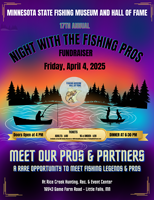 "A passion for fishing, bred into us for generations gives us a common bond. Today, anglers head outside to “test our luck” on fishing lakes and streams all over the state.
"A passion for fishing, bred into us for generations gives us a common bond. Today, anglers head outside to “test our luck” on fishing lakes and streams all over the state.
The reward for our pursuits varies, for some, only participation in the highest forms of competition while deploying the latest technology is good enough. For others, standing on the bank, hoping for a bobber to go down is equally rewarding. For most of us, happiness lies fishing somewhere between.
It is rewarding to me, to remember the history of fishing in Minnesota. Honoring where we came from, and at the same time, paying attention to where we’re headed. Minnesota’s Fishing Museum, and Fishing Hall of Fame offer a connection between the two. I wholeheartedly support the Minnesota Fishing Museum, and the Minnesota Fishing Hall of Fame. I’d love it if you would ..." Read >> "A Night with the Pros" | MN Fishing Museum and Hall of Fame 2025
 January 30, 2025 Maps and Charts 101 | "Wrapping the Wrap-Able"
January 30, 2025 Maps and Charts 101 | "Wrapping the Wrap-Able"
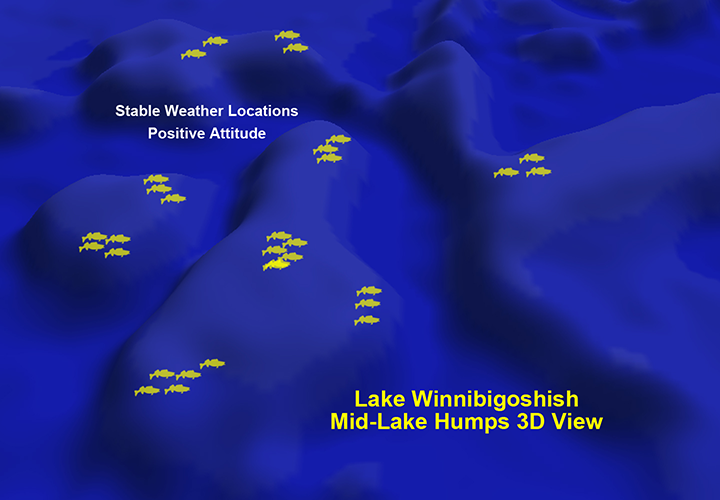 Today’s installment marks the end of my Mapping and Charting 101 series. The topic, mid-lake humps, wasn’t included in Richard Mullet’s original list of questions, but it’s only logical to include it as we wrap up. So, let’s talk today about humps in general, and then use them to practice some of the terminology we discussed this past week.
Today’s installment marks the end of my Mapping and Charting 101 series. The topic, mid-lake humps, wasn’t included in Richard Mullet’s original list of questions, but it’s only logical to include it as we wrap up. So, let’s talk today about humps in general, and then use them to practice some of the terminology we discussed this past week.
“Humps” differ from the January 22, 2025, topic “breaklines and bars” in that mid-lake humps are free-standing structures, not shoreline related.
“Humps” may also be called reefs, sunken islands or mudflats; names vary by region. No matter the nicknames, their common feature is that they do not connect to the main shoreline. Depending on the size and structure of your favorite lakes, they could ..." Read Full Article >> MID LAKE HUMPS AND MUD FLATS
 Ely Area, Arrowhead Outdoors Fishing Report January 30, 2025
Ely Area, Arrowhead Outdoors Fishing Report January 30, 2025
 "Walleye fishing took a turn for the better this last week as several sleeper houses reported catching limits of walleyes overnight. Key depth for these houses was 12 feet of water. Deadsticking a minnow under a rattle reel was the most effective way to catch walleye. Small handful of anglers also reported catching walleyes in 25 to 30 feet of water, also deadsticking a minnow near the bottom.
"Walleye fishing took a turn for the better this last week as several sleeper houses reported catching limits of walleyes overnight. Key depth for these houses was 12 feet of water. Deadsticking a minnow under a rattle reel was the most effective way to catch walleye. Small handful of anglers also reported catching walleyes in 25 to 30 feet of water, also deadsticking a minnow near the bottom.
Lake Trout - Fishing for lake trout was a little mixed this last week as warm temps and high winds came to the area. Anglers that were able to locate the active lakers reported catching good numbers with some quality trout mixed in by the end of the day. Bait of choice bounced from bucktails, to tube, to jigging spoons, so if you're marking trout but fail to get hookups, switch baits. Best depth remains 30 to 40 feet of water.
Stream Trout - Rainbow trout and Splake were popular targets this last week and for the most part cooperated with anglers. Rainbow trout were mainly found cruising downed and standing timber. Depth for them was 20 to 50 feet of water. Splake too could be found in those depths, but 15 to 30 feet of water seemed to be a little bit better. Small spoons, small tungsten jigs and rippin raps were all effective baits for catching both rainbows and Splake.
Eelpout - Multiple reports of eelpout being caught on several different lakes in the Ely area have been coming in. Seems 5 to 12 feet of water, near river mouths is where eelpout are being caught. Deadsticking a lively minnow and jigging brightly glowing spoons, loaded with smelt chunks or minnow chunks and pounded on the bottom has been effective.
Panfish - Reports about fishing for sunfish and crappies were limited this last week. This is simply not the time of year when anglers spend time targeting them. Those who have, are reporting slow fishing. Best location is 25 to 30 feet of water for anglers who have located them. Small jigs tipped with a wax worm or crappie minnow were effective in getting them to bite." — Arrowhead Outdoors, 218-365-5358
 January 29, 2025 "A Solid Foundation of Knowledge"
January 29, 2025 "A Solid Foundation of Knowledge"
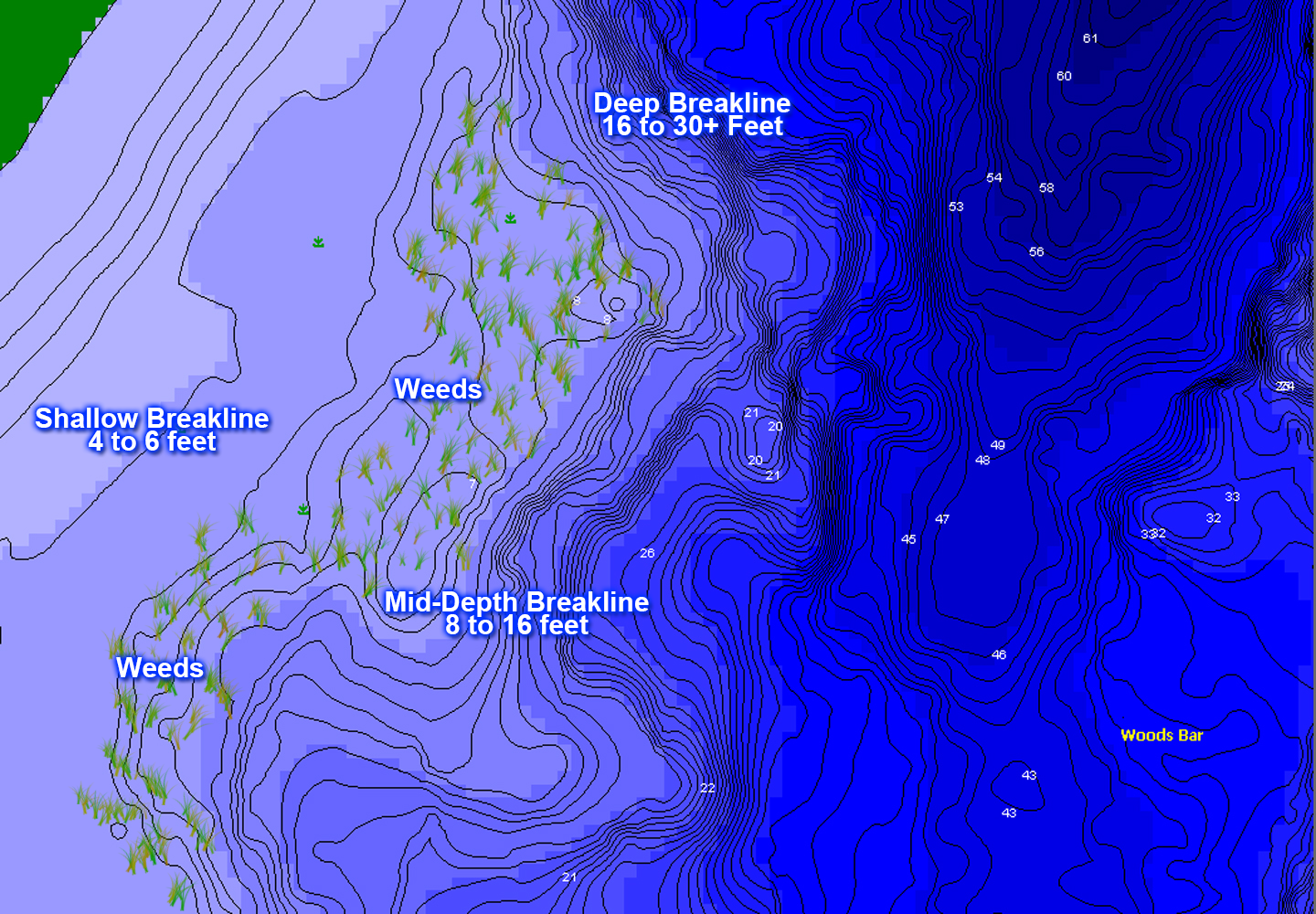 I think we’ve laid the groundwork for answering Richard Mullet’s January 22, 2025 Q&A about defining lake structures and terminology. Today, I think we can drill into some more specifics about the topic of “break lines.”
I think we’ve laid the groundwork for answering Richard Mullet’s January 22, 2025 Q&A about defining lake structures and terminology. Today, I think we can drill into some more specifics about the topic of “break lines.”
Knowing what a breakline is does give us a common vocabulary that allows us to share information with our fellow anglers. It’s great when somebody gives us a “hot tip” about catching fish in Lake Wishiknew, somewhere along a shoreline break, or on mid-lake structures and the like. But how can anglers, like Richard, pick up a paper map, or fire up his Lakemaster chart and find their own spots that might be productive?
Let’s take a look at one of the scenarios I look for when I’m preparing to fish a “new” walleye lake.
The image of the Lakemaster chart (upper left) shows the kind of spots I’m looking for when I want to ..." Read Full Article >> Understanding Lake Charts and Mapping "Breakline Drilldown A Closer Look"
 January 28, 2025 "Weed Lines, Weed Flats and Weed Mats"
January 28, 2025 "Weed Lines, Weed Flats and Weed Mats"
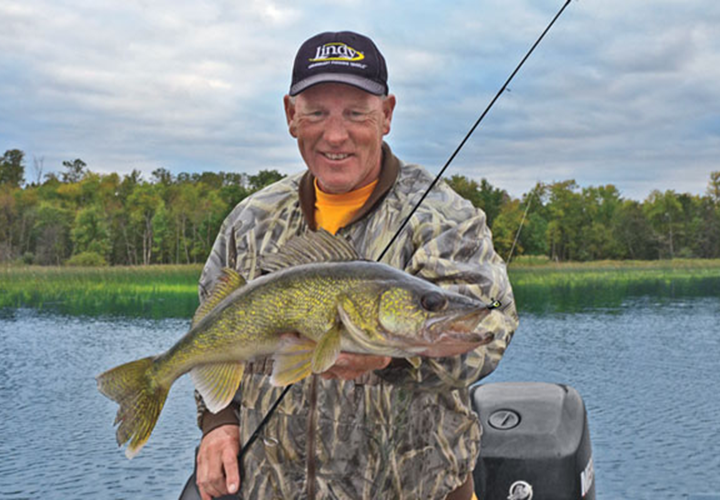 The search for definitions about weed lines, weed patches and fishing in vegetation was part of the original reader Q&A that got me started on this series about charts, maps and fishing terminology. Fishing in weeds is a big topic and warrants an entire book of its own. In the interest of keeping the discussion simple though, I’ll offer you some general guidance about the definitions, maybe not so much detail about how to fish in them
The search for definitions about weed lines, weed patches and fishing in vegetation was part of the original reader Q&A that got me started on this series about charts, maps and fishing terminology. Fishing in weeds is a big topic and warrants an entire book of its own. In the interest of keeping the discussion simple though, I’ll offer you some general guidance about the definitions, maybe not so much detail about how to fish in them
Submerged vegetation varies not only from lake to lake, but from one region of the Midwest to another. The underwater grasses that I discover in lakes within my home territory may not even exist in yours, and vice versa. So, knowing that I can never address every definition of weed formations in your lake, take my advice and modify it to fit your needs. Vegetation that you encounter will in some way be similar to the varieties that I describe here.
A “weed line”, to me, refers to the ..." Read Full Article >> Weed Lines, Weed Flats and Weed Mats
 Lake of the Woods, LOW Tourism January 28, 2025
Lake of the Woods, LOW Tourism January 28, 2025
 "Ice fishing is going great across the south shore of Lake of the Woods. We continue to receive good fishing reports and opportunities keep expanding as ice conditions improve. Many ice roads are now extending more than 12 miles out, with over two feet of ice reported in most areas. Resorts and outfitters are increasing weight limits, and many roads are now open to 1-ton vehicles pulling wheelhouses. Be sure to check with each resort for the latest weight limit and road condition updates before heading out.
"Ice fishing is going great across the south shore of Lake of the Woods. We continue to receive good fishing reports and opportunities keep expanding as ice conditions improve. Many ice roads are now extending more than 12 miles out, with over two feet of ice reported in most areas. Resorts and outfitters are increasing weight limits, and many roads are now open to 1-ton vehicles pulling wheelhouses. Be sure to check with each resort for the latest weight limit and road condition updates before heading out.
Fishing this past week has been very good with consistent action for anglers. Most fishing activity is taking place in 26 to 32 feet of water. Resorters and rental operators are proactively moving fish houses to stay on schools of walleyes and saugers.
Anglers are finding a healthy mix of walleyes and saugers, with plenty of opportunities to enjoy fresh fish meals and bring fish home. The limit of walleyes and saugers is a combined limit of 6 fish, up to 4 can be walleyes. All walleyes 19.5 to 28.0 inches must be released. If desired, anglers are allowed to legally keep, and have in posession, one walleye over 28.0 inches or larger.
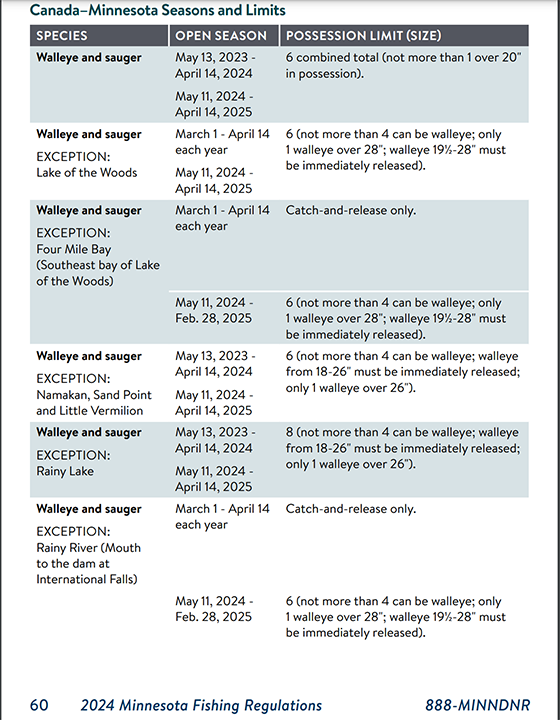 Anglers are catching lots of jumbo perch in the mix this year. Other species making appearances include eelpout (burbot), pike, tullibees, crappies, and the occasional sturgeon.
Anglers are catching lots of jumbo perch in the mix this year. Other species making appearances include eelpout (burbot), pike, tullibees, crappies, and the occasional sturgeon.
The "one-two punch" of jigging a spoon or lipless crankbait in one hole to attract active fish, and a live minnow on a plain hook or small jig in the second hole for deadsticking. For the jigging line, rippin raps, pink charmers, coffin spoons, leech flutter spoons, and rattling flyer spoons have been effective. Tip spoons with a minnow head or tail. On the deadstick, use a plain hook or a small jig with a live minnow 6 inches to a foot off of the bottom.
Electronics are highly recommended to help anglers locate suspended fish, track movements, and adjust presentations based on the fish's mood. Most resorts and bait shops rent electronics for those without their own.
On the Rainy River, reports from guests say the river continues to produce some walleyes and saugers during the morning and evening hours. A jig and minnow combination remains effective for targeting these fish. Catch-and-release sturgeon fishing has also been good for anglers who enjoy battling these prehistoric giants. The preferred setup involves drilling oversized holes or three holes together, using nightcrawlers or frozen emerald shiners on a sturgeon rig fished along the bottom.
Ice conditions on the river vary significantly due to the current, so anglers should always consult local resorts or outfitters for the most up-to-date safety information and fishing advice.
Up at the Northwest Angle, ice fishing continues to be very good at the Northwest Angle. Resorts have spread out their fish houses across a variety of areas, some fishing on structure and others targeting deeper mud flats. Anglers are reporting a nice mix of walleyes, saugers, jumbo perch, pike, and tullibees. Good numbers of big crappies being caught amongst the islands, inquire with NW Angle resorts to book a crappie house. Good colors are gold, glow red, glow white, Wonder bread, pink, chartreuse and orange, or a combo of these colors.
With thickening ice, the rest of the ice fishing season is looking strong. Lake of the Woods enjoys an extended ice fishing season with fish houses on the ice through March 31, 2025 and walleye and sauger seasons open through April 14, 2025. Perch, crappie, and pike seasons remain open year-round." — Lake of the Woods Tourism, (800) 382-FISH
 Wired2Fish January 28, 2025 "How to Catch More Crappies During Winter Months"
Wired2Fish January 28, 2025 "How to Catch More Crappies During Winter Months"
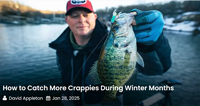 "Jack Uxa of Jack’s Guide Service on Lake of the Ozarks shares advice for finding and catching winter crappies on reservoirs. During the colder months, crappies tend to group in larger schools and hold in areas longer, making them easier to target. With the right approach and gear, anglers can experience the finest crappie fishing of the season.
"Jack Uxa of Jack’s Guide Service on Lake of the Ozarks shares advice for finding and catching winter crappies on reservoirs. During the colder months, crappies tend to group in larger schools and hold in areas longer, making them easier to target. With the right approach and gear, anglers can experience the finest crappie fishing of the season.
HOW TO LOCATE WINTER CRAPPIES: Winter crappies gather near main lake points, docks, and brush piles. Uxa explains how to find these schools using forward-facing sonar while maintaining the proper distance to prevent spooking the school and make effortless casts. He then discusses where to ..." View Video and Learn More >> How to Catch More Crappies During Winter Months
 January 27, 2025 "MAIN LAKE FLATS Mysterious, But Productive"
January 27, 2025 "MAIN LAKE FLATS Mysterious, But Productive"
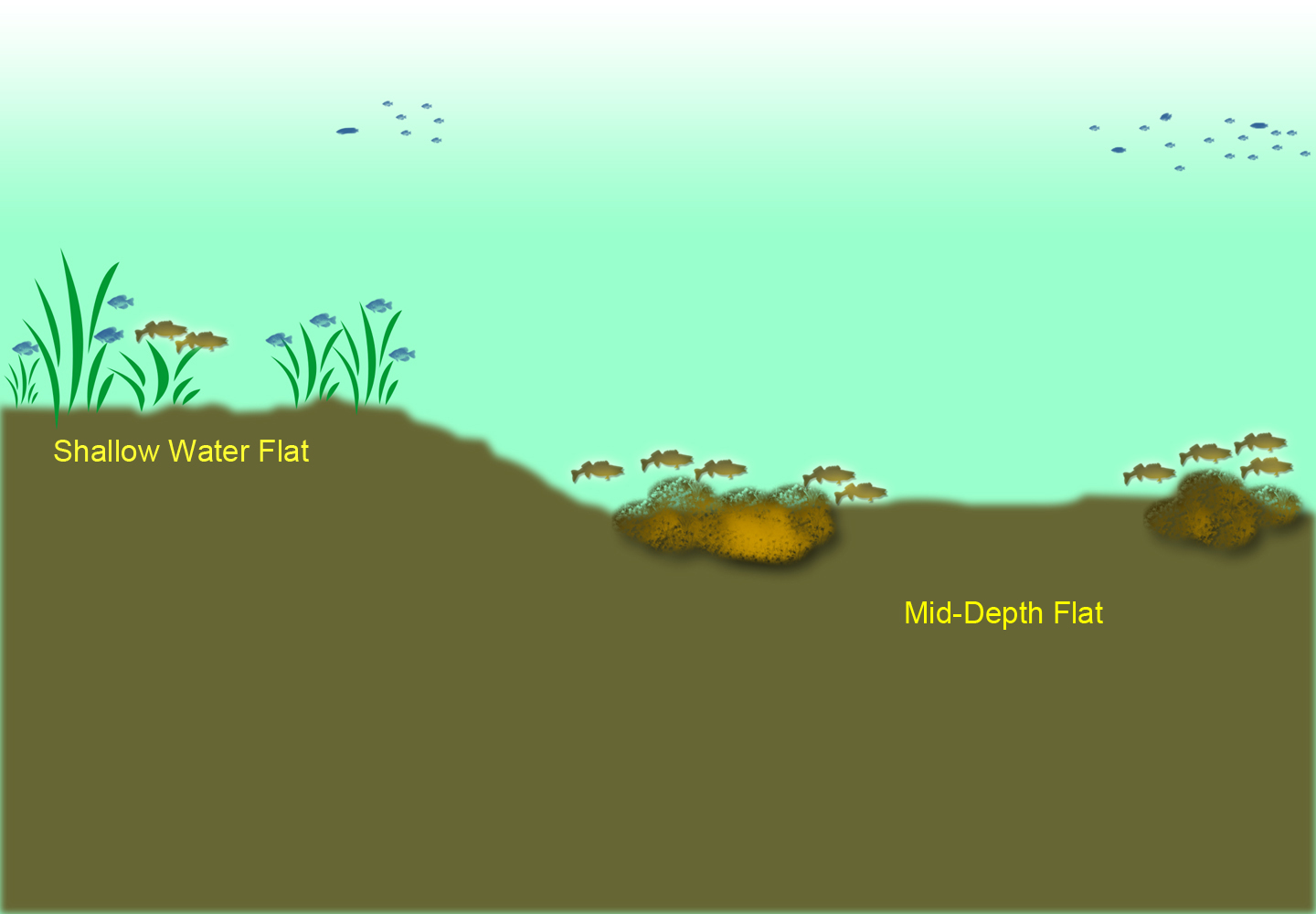 Flats, and where to fish on them, can drive “structure anglers” like me crazy. Why? Because of the seemingly endless amount of “structureless territory” that they occupy on many of my favorite lakes. Flats are important to anglers because fish, at one time or another, could turn up almost any place on a flat.
Flats, and where to fish on them, can drive “structure anglers” like me crazy. Why? Because of the seemingly endless amount of “structureless territory” that they occupy on many of my favorite lakes. Flats are important to anglers because fish, at one time or another, could turn up almost any place on a flat.
For me, defining a flat is easy; any long, sprawling region of a lake where water depths change little, if at all. When you cannot find a drop off, or a weedline, or come across any fast-changing depths readings on your sonar, then you’re on a flat. Flats can, and often do occur in shallow water, mid-depth range water and again, in deep water.
Depending on the lake, and fishing pattern a writer is describing, you could hear terms like “mud-flats”, “sand-flats”, “weed-flats” and ..." Read Full Article >> "MAIN LAKE FLATS Mysterious, But Productive"
 Wired2Fish January 27, 2025 "Best Fish Finders for 2025"
Wired2Fish January 27, 2025 "Best Fish Finders for 2025"
 "While much debate seems to circle fish finders, they are one of the best ways to improve your efficiency on the water. And have become invaluable for learning fish behavior and migrations. What started simply as a way to tell how deep the water was around you, over generations, has morphed into one of the most elaborate tools for finding fish and learning a fishery.
"While much debate seems to circle fish finders, they are one of the best ways to improve your efficiency on the water. And have become invaluable for learning fish behavior and migrations. What started simply as a way to tell how deep the water was around you, over generations, has morphed into one of the most elaborate tools for finding fish and learning a fishery.
It took breaking down massive reservoirs and made it manageable for anyone without decades of personal experience on those lakes. So knowing the best fish finders will give you better insight into which units fit your type of fishing and budget to be more effective on the water." Read Full Story and Learn More >> Best Fish Finders for 2025
 January 26, 2025 "More Charting the Chart-Able Mid-Lake Bars"
January 26, 2025 "More Charting the Chart-Able Mid-Lake Bars"
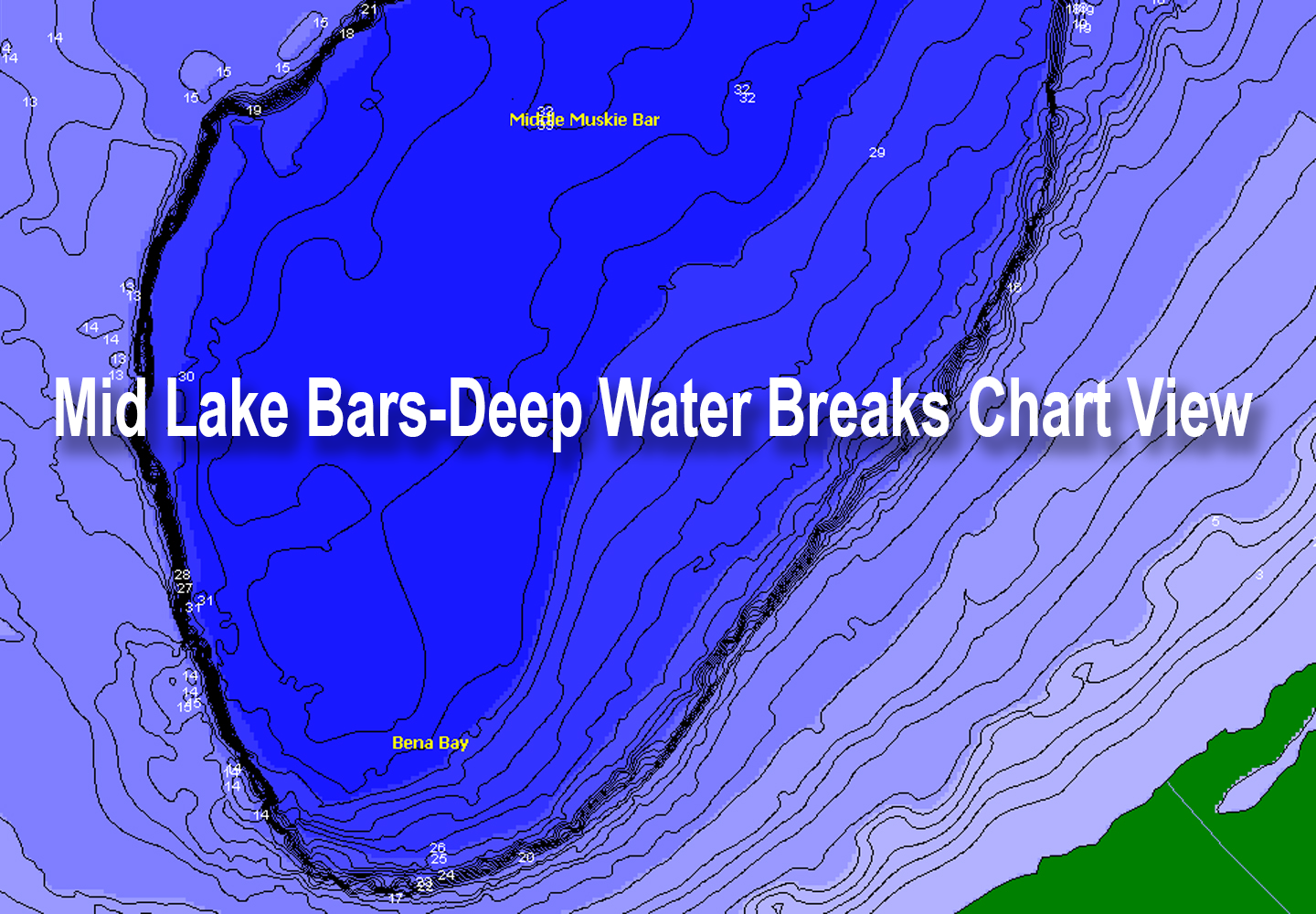 To study mid-lake bars, the most common of all open-water structure, I’ve chosen a map of Lake Winnibigoshish in Minnesota’s Cass County. My reason for this choice is that folks who fish on Winnie frequently use the term “bars” to describe numerous fishing areas on the lake.
To study mid-lake bars, the most common of all open-water structure, I’ve chosen a map of Lake Winnibigoshish in Minnesota’s Cass County. My reason for this choice is that folks who fish on Winnie frequently use the term “bars” to describe numerous fishing areas on the lake.
As you can see, “The Bena Bar” pictured here is actually a steep breakline that leads from the shoreline, all the way out to the lake’s deepest water. Following the edges of the bar in either direction takes anglers on trip around that deep water hole.
Depending on which region we fish, anglers may also refer to “bars” using other names. “Deep water breakline”, “mid-lake breakline”, or “deep basin breakline” would all ..." Read Full Article >> "More Charting the Chart-Able Mid-Lake Bars"
 Wired2Fish January 26, 2025 "Best Musky Lures | From Top to Bottom"
Wired2Fish January 26, 2025 "Best Musky Lures | From Top to Bottom"
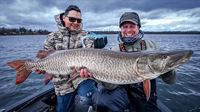 "Musky, also known as muskellunge (or “muskie”), are among the most sought-after game fish in North America because of their large size and bad attitude. But despite their aggressive nature, it can be tough to convince this mega-predator to eat, earning it the nickname, “the fish of ten thousand casts.” If you want to consistently score with these oversized members of the Esox family, you have to understand their diet — and be armed with the best musky lures.
"Musky, also known as muskellunge (or “muskie”), are among the most sought-after game fish in North America because of their large size and bad attitude. But despite their aggressive nature, it can be tough to convince this mega-predator to eat, earning it the nickname, “the fish of ten thousand casts.” If you want to consistently score with these oversized members of the Esox family, you have to understand their diet — and be armed with the best musky lures.
So, What do Muskies Bite On? I recently talked about muskies with a fishery biologist, who works for the Minnesota Department of Natural Resources. He’d recently completed a study on their food habits in eight Minnesota lakes. This type of information is important because of the ..." Learn More >> Best Musky Lures | From Top to Bottom
 January 25, 2025 "Understanding Lake Charts Submerged Shoreline Points"
January 25, 2025 "Understanding Lake Charts Submerged Shoreline Points"
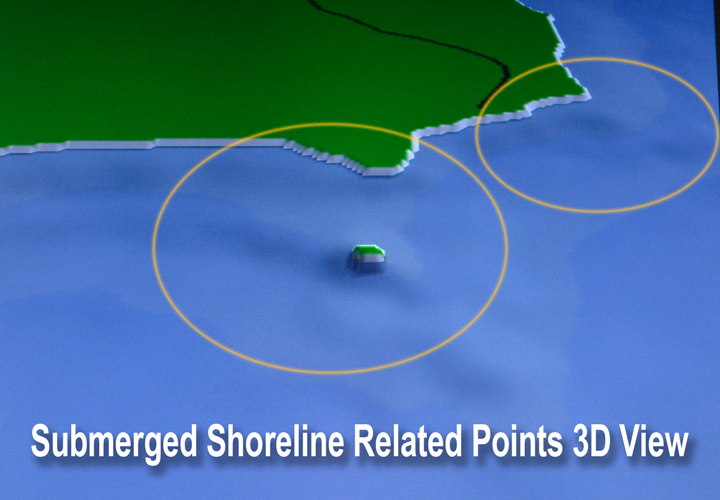 So far, we’ve compared images of steep breaklines, and soft, slow tapering breaklines. Descriptions of both are simple, and straightforward, making interpretation easy.
So far, we’ve compared images of steep breaklines, and soft, slow tapering breaklines. Descriptions of both are simple, and straightforward, making interpretation easy.
Eventually, we’ll get into more complex and nuance structures, but in the interest of building on a solid foundation, let’s continue with a few more basic structures. Today, let’s talk about submerged, shoreline related points.
“Shoreline Related” simply means that the structure, or structures are connected directly to the adjacent land mass. So, points can occur not only along the main shoreline of a lake, but also adjacent to islands found further in the lake.
Note: Structures that are not directly connected to a land mass will ..." Read Full Article >> "Understanding Lake Charts Submerged Shoreline Points"
 January 24, 2025 "MN Fishing Hall of Fame 2025 Inductees Welcoming the Welcome-Able"
January 24, 2025 "MN Fishing Hall of Fame 2025 Inductees Welcoming the Welcome-Able"
 I want to offer heartfelt congratulations to all of the 2025 Minnesota Hall of Fame inductees. I can’t think of a better crew to be enshrined!
I want to offer heartfelt congratulations to all of the 2025 Minnesota Hall of Fame inductees. I can’t think of a better crew to be enshrined!
Knowing a lot of people just happens naturally whenever a person hangs around anyplace long enough. I guess that’s what happened to me, because when I read the Minnesota Fishing Hall of Fame announcement about inductees for 2025, I realized that almost all of them happen to be “friends” of mine. That’s why I feel like I can offer this firsthand endorsement that all of these guys have worked extremely hard and have well served their fellow anglers in Minnesota and beyond. Their recognition is earned, and well deserved, and I hope you’ll join me in welcoming them.
Don Pursch and I first met close to 40 years back, when he was in transitioning out of his role at Camp Fish, in Walker, MN and starting his Canadian fishing camp, on Rowan Lake. At the time, I made him a “special stash” of tube jig heads to be used for lake trout fishing. Over the years, we’ve stayed in touch a little bit, mostly via “social media” pages.
Jimmy Bell and I have “rubbed elbows” at various boat shows and fishing events for 20 years? I see him more these days because of his role with the Student Anglers Association, Lund Boats, and MN-Fish.
Jon Thelen first offered me a “pro-staff” opportunity with Lindy Fishing Tackle, in about 2009. I took him up on it and for about the next 10 years, we spent a lot of time alongside each other. We worked closely together, completing one promotional fishing project after another, including fishing articles, fishing videos, television programs and photography.
Ray’s Marine, my go-to store for Lund Boats, Mercury Engines, Humminbird, MinnKota and more, Jim Hernesman first offered me a "pro-staff" spot in 1989 and I've been on board ever since. Theirs, a true family run business, have been keeping me “up and running” for about 35 years now and whenever I walk in the door at the Grand Rapids store, I feel like I’m part of the family too.
I don’t happen to live close enough to Neshaim Bait to have known them personally. But just because I didn’t have a firsthand relationship with them doesn’t mean they’re not equally deserving of H.O.F induction. By all accounts they are, and I'm sure they've worked plenty enough to have eartned it!
I wholeheartedly support the Minnesota Fishing Museum, and the Minnesota Fishing Hall of Fame. I’d love it if you would save a couple of dates and come and join us in welcoming the inductees into the H.O.F. “A Night With the Pros”, Friday April 4, 2025 and “Minnesota Hall of Fame Induction” ceremony, Friday September 26, 2025. Follow this link for details about the events, and to read more about this year’s inductees.
Minnesota Fishing Museum, and the Minnesota Fishing Hall of Fame
![]() — Jeff Sundin, The Early Bird Fishing Guide Office Cell Call or Text 218-245-9858 or Email
— Jeff Sundin, The Early Bird Fishing Guide Office Cell Call or Text 218-245-9858 or Email
 Wired2Fish January 24, 2025 "White Perch | America’s Most Underrated Panfish"
Wired2Fish January 24, 2025 "White Perch | America’s Most Underrated Panfish"
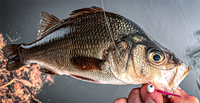 "When most anglers think of perch fishing, they think of filling coolers with the tasty striped variety, thinking about little besides getting a delicious perch fish fry going after a long day on the water. But what if I told you there was a better tasting perch species that could be targeted all winter long? Enter the white perch.
"When most anglers think of perch fishing, they think of filling coolers with the tasty striped variety, thinking about little besides getting a delicious perch fish fry going after a long day on the water. But what if I told you there was a better tasting perch species that could be targeted all winter long? Enter the white perch.
These fish will keep your line tight throughout the winter doldrums without having to drill a 6-inch hole in the ice. For many anglers across the country, especially those along the East Coast, this species is barely on the radar. But once you find them, white perch can provide you with some of the best days of fishing you’ll have all winter.
History on the “Silver Bass”
The white perch (Morone americana) isn’t actually a member of the perch family. It is more closely related to the ..." Learn More >> White Perch | America’s Most Underrated Panfish
 Ely Area, Arrowhead Outdoors Fishing Report January 23, 2025
Ely Area, Arrowhead Outdoors Fishing Report January 23, 2025
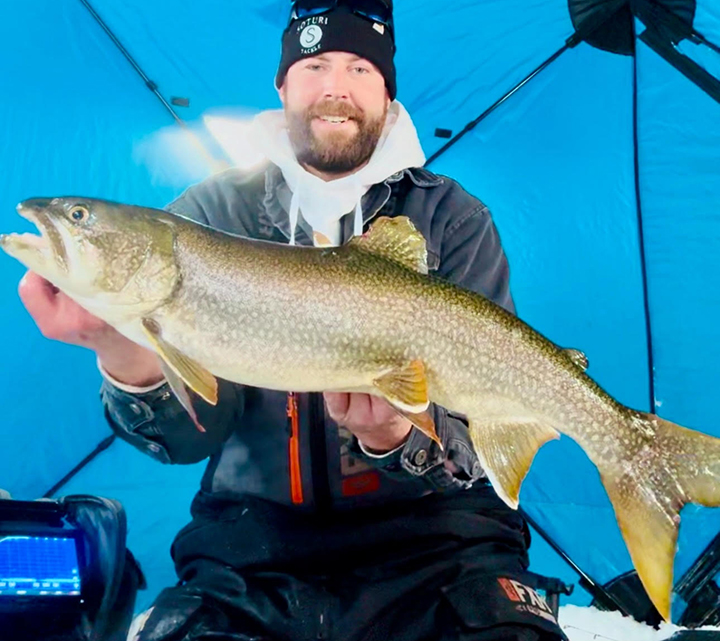 "Lake Trout - Overall, lake trout anglers were not disappointed for lake trout opener. Many anglers reported catching good size lakers with white flukes, tubes, Swedish Pimples and bucktails. Key depths were 30 to 50 feet of water, with flats and large main lake points, close to very deeper water, were the best locations to find active lakers. Live suckers suspended 10 to 15 feet under the ice also produced lakers.
"Lake Trout - Overall, lake trout anglers were not disappointed for lake trout opener. Many anglers reported catching good size lakers with white flukes, tubes, Swedish Pimples and bucktails. Key depths were 30 to 50 feet of water, with flats and large main lake points, close to very deeper water, were the best locations to find active lakers. Live suckers suspended 10 to 15 feet under the ice also produced lakers.
Stream Trout fishing hit with a bang for just about everyone who targeted them. Majority of groups reported that they had caught their limit before noon on opening day and threw back another limit.
Small jigging spoons, tipped with a wax worm or dead minnow, and fished 5 to 10 feet under the ice, was deadly. Anglers targeting brookies found brookies tight to shorelines in 6 feet of water or less. Dead minnows on a small jigging spoon was very effective here.
Walleye fishing continues to be slow. Anglers catching any walleyes have been catching them over night on dead sticks. Bright glowing jig tipped with a minnow has been the ticket for getting bites. Best depth continues to be in that 25 to 30 feet of water range. Deep rocks or mud flats have both good areas to fish.
Eelpout reports have begun to pop up. Anglers have been finding eelpout in shallow water in 5 to 10 feet of water. Shallow rocks and shallow rocks near creek mouths have been areas to target. Jigs loaded with minnow chunks or smelt chunks and fished close to the bottom. Many anglers have been reporting that the eelpout they are catching are full of crawfish." — Arrowhead Outdoors, 218-365-5358
 January 23, 2025 "Maps and Charts Interpretation — Continuing the Continue-Able"
January 23, 2025 "Maps and Charts Interpretation — Continuing the Continue-Able"
 Reports of a successful trout fishing opener, mentioned in the Arrowhead Outdoors ice fishing report above were shared by other Minnesota anglers too. My friend Dustin Monson posted a report from north central Minnesota. He and his son caught several lake trout, mostly smaller fish, one weighing in at about 5 pounds. “We drilled holes, and fished them for a couple of hours, moving to new territory whenever fish sightings stopped.” Monson said. They were using Jigging Rapalas and white tube jigs.
Reports of a successful trout fishing opener, mentioned in the Arrowhead Outdoors ice fishing report above were shared by other Minnesota anglers too. My friend Dustin Monson posted a report from north central Minnesota. He and his son caught several lake trout, mostly smaller fish, one weighing in at about 5 pounds. “We drilled holes, and fished them for a couple of hours, moving to new territory whenever fish sightings stopped.” Monson said. They were using Jigging Rapalas and white tube jigs.
Our daughter Joelle and her fiancé’ Patrick spent their day on a lake in the Grand Marais area. Fishing in about 45 feet of water, both used “Rippin’ Shads”, Pat’s was all white, Jo’s was white, but with polka dots. The highlight of their day came at mid-morning when the nice laker appeared on their depth finder screens and appeared to be confused about which lure to strike. The lucky winner (pictured above) was Patrick this time. The duo had some more action too, but the best fish of the day managed to give them the slip, coming off the hook before it could be landed.
Further south, I spied images of a group of anglers who fished a smaller lake for stream trout. I haven’t secured permission to share the report, or images of the fish. But I can tell you that they had a sled filled with stream trout, 25 of them, a full five angler limit. That group was fishing in shallower water, there was a visible weed line in the images, and they appeared also to be using white tube jigs, if there were other lures used, they were not mentioned.
![]() Yesterday, in response to a reader inquiry, I started a lake map interpretation project. If you missed seeing it, scroll down the page to start from the beginning or click here for the full report >> Leech Lake Fishing Maps and Charts 01-22-2025
Yesterday, in response to a reader inquiry, I started a lake map interpretation project. If you missed seeing it, scroll down the page to start from the beginning or click here for the full report >> Leech Lake Fishing Maps and Charts 01-22-2025
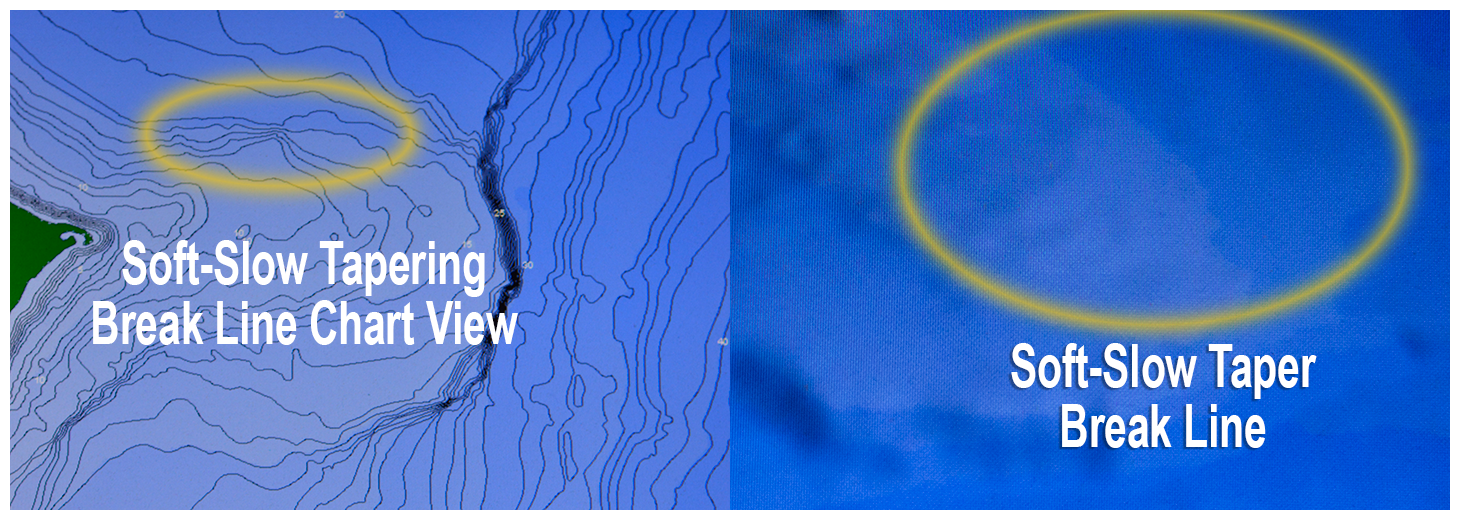 In today’s report, I’ve included these images of a chart from the same area, just off of Stony Point on Leech Lake, that shows what a soft, or slow-tapering break line looks like.
In today’s report, I’ve included these images of a chart from the same area, just off of Stony Point on Leech Lake, that shows what a soft, or slow-tapering break line looks like.
Notice how much further the depth lines are spaced compared to the tightly gathered spacing from yesterday’s image of a sharp breakline. Slow tapering drop off areas like these can be more difficult to notice on the electronics in your boat, but don’t overlook them, they are important! Fish that roam for forage like walleyes, perch and sometimes crappies, use these slow tapering breaks when they’re feeding. When scoping out complex structures, look for areas like these that lay adjacent to other structures like points, humps and rock piles.
Speaking of points, that’s where we’ll pick up the discussion tomorrow. I’ll offer illustrations that show what a “point” looks like on your map, and under the surface in 3D form. Check back again tomorrow for another pair of illustrations. ![]() — Jeff Sundin, The Early Bird Fishing Guide Office Cell Call or Text 218-245-9858 or Email
— Jeff Sundin, The Early Bird Fishing Guide Office Cell Call or Text 218-245-9858 or Email
 January 22, 2025 "Understanding Lake Charts and Mapping Terminology"
January 22, 2025 "Understanding Lake Charts and Mapping Terminology"
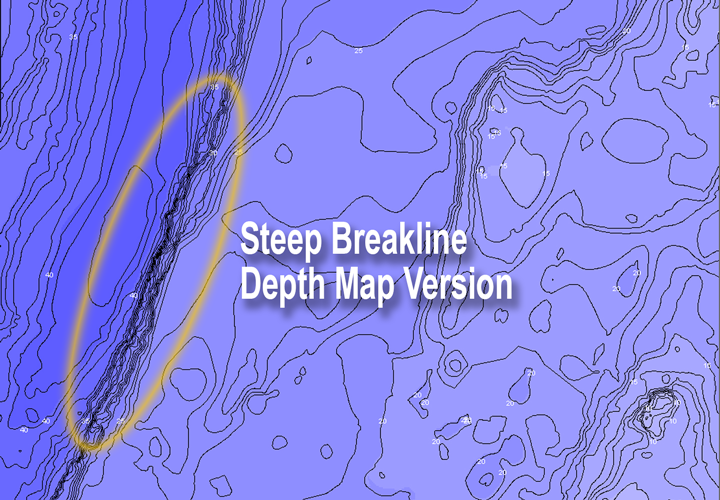 Occasionally, I receive reader comments or questions that require more than a casual answer. On Monday, this email message from Richard Mullet was one of them.
Occasionally, I receive reader comments or questions that require more than a casual answer. On Monday, this email message from Richard Mullet was one of them.
Q) “Jeff, I have enjoyed following you as well as others in trying to improve my fishing skills. One thing that has baffled me for a long time is how to read a lake map correctly. I hear people using terms like breaks, breaklines and that one should fish above the breaks, below the breaks, follow the break lines, fish the flats etc etc.!
I am confused by all that terminology. What exactly is a break? How is a flat defined? Is (the area) where the weeds stop considered (to be) the break line? I have maps on my electronics, and I see the depth lines. Is each line described as a break or break line every time it changes from 10 to 12 feet for example? Could you direct me to a source where I can learn what all these terms mean and how I might apply them? I want to learn but have never heard anyone actually define in a way so my simple brain can comprehend! Thanks for all you do. You are one of the best! Thank you, Richard Mullet”
A) Richard, Wow, as my grandmother used to say, “that’s a mouthful!” First off, thank you for the vote of confidence in my ability to deliver meaningful answers to your questions. Your questions are important, in fact, they're so important that I've decided to open and brand new section on the website. On February 1, 2025, answers to these questions have been moved to the new "The Fish Rapper Angling Information Basics Section". Folow the links for each topic, categorized indivudually.
Maps and Charts Interpretation Sections
- Maps and Charts Interpretation: BREAKLINES
- Maps and Charts Interpretation: SOFT BREAKS
- Maps and Charts Interpretation: SUBMERGED SHORELINE POINTS
- Maps and Charts Interpretation: MID LAKE BARS
- Maps and Charts Interpretation: MAIN LAKE FLATS
- Maps and Charts Interpretation: WEEDLINES vs WEED FLATS
- Maps and Charts Interpretation: BREAKLINES A CLOSER LOOK
- Maps and Charts Interpretation: MID-LAKE HUMPS
 Lake of the Woods, LOW Tourism January 21, 2025
Lake of the Woods, LOW Tourism January 21, 2025
 "On the south shore of Lake of the Woods, resort staff and ice fishing outfitters are reporting ice thicknesses of over two feet in many areas. Every road has different weight limits, but many are oiffering access for heavier setups, and many are allowing anglers with 1 ton pickups, combined with large wheel houses. So, if you have a heavy rig, checking with each resort for details before traveling up is imporatant.
"On the south shore of Lake of the Woods, resort staff and ice fishing outfitters are reporting ice thicknesses of over two feet in many areas. Every road has different weight limits, but many are oiffering access for heavier setups, and many are allowing anglers with 1 ton pickups, combined with large wheel houses. So, if you have a heavy rig, checking with each resort for details before traveling up is imporatant.
As you'd expect, ice fishing is in full swing on the south shore of Lake of the Woods. Despite cold temperatures and windy conditions, most have enjoyed very good fishing this past week. As a rule, fishing activity is happening in 26 to 32 feet of water, and resorts continue to move fish houses deeper, hoping to stay on mixed schools of walleyes and saugers.
Most groups are having plenty of fresh fish to eat along with bringing fish home. A wide range of sizes of walleyes and saugers are showing up, which shows a healthy fishery. Anglers are sorting through fish, releasing small fish and walleyes in the protected slot between 19.5 to 28.0 inches. Anglers are allowed to POSESS one walleye measuring 28.0 inches, or larger if they so desire.
It continues to be a very good year for jumbo perch with good numbers being caught. Other fish in the mix are eelpout (burbot), pike, tullibees and an occasional sturgeon.
Electronics are very helpful to see suspended fish, know when fish are coming through and adjust your presentation to the mood of each fish. Most resorts, outfitters and bait shops in the area rent electronics by the day. Using the 1-2-punch of using jigging presentations in one hole, and a "dead stick" presentation in the second hole. A jigging spoon or lipless crankbait in the jigging hole and a live minnow on a hook or small jig in the deadsticking hole.
The Rainy River is still producing some nice walleyes and saugers, primarily in the mornings and evenings, and jig and minnow working presentations are working well. Catch-and-release sturgeon fishing continues to be good for those targeting them. An oversized hole, or three holes drilled together, with nightcrawlers or frozen emerald shiners on a sturgeon rig fished on the bottom are what anglers are using.
Ice conditions on the river can vary significantly due to the current. To stay safe and maximize success, always work with a local resort or outfitter familiar with river conditions.
Ice continues to thicken and fishing continues to be very good up at the Northwest Angle as well. Resorts are spread out on a variety of areas, some on the structure, some set just off of structure in the deep mud. A nice mix of walleyes, saugers, jumbo perch, pike and tullibees are being caught. The ice road from Jerry's on the mainland (Angle Inlet, MN) to island resorts is open to 1 ton vehicles. Guests drive right to their island resort after picking up a road pass at Jerry's or Point North Services.
With thickening ice, an ice fishing season through March is shaping up nicely. Lake of the Woods enjoys an extended ice fishing season through March 31, 2025. Walleye and sauger season is open through April 14, 2025 and perch, crappie, and pike season never closes." — Lake of the Woods Tourism, (800) 382-FISH
 January 16, 2025 "Minnesota Trout Fishing Opens on January 18, 2025"
January 16, 2025 "Minnesota Trout Fishing Opens on January 18, 2025"
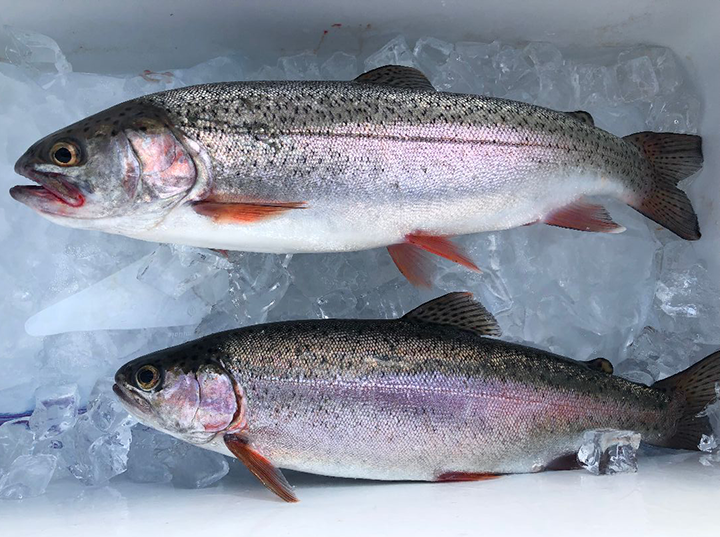 I’ve said before that the ideal world of ice fishing, for me, would be a 200-acre lake, a good path to walk on, and a comfortable place to sit. These days, ice fishing for stream trout on Minnesota’s designated trout waters is as close to that ideal as an angler can find. Many designated trout lakes are walk-in, non-motorized areas where peace and quiet is the norm, not the exception.
I’ve said before that the ideal world of ice fishing, for me, would be a 200-acre lake, a good path to walk on, and a comfortable place to sit. These days, ice fishing for stream trout on Minnesota’s designated trout waters is as close to that ideal as an angler can find. Many designated trout lakes are walk-in, non-motorized areas where peace and quiet is the norm, not the exception.
The inland water trout season opens this weekend, on January 18, 2025, and a friend reminded me recently about some opportunities we have right here, in the Grand Rapids region. There are others too, trout lakes are sprinkled all around the entire state and finding a place to go trout fishing is easy. An interactive map shows where the trout lakes are, and the click-able map links take us to specific information about each of the lakes.
Click on the accompanying image that links to the interactive >> “MN Trout Fishing Streams-Lakes MAP”. OR if you already have a specific lake or county in mind, follow this link to a sortable, interactive table containing more detailed information, follow this link to >> “Table of MN Trout Lakes and Streams”.
Once you choose a lake, you might discover that fishing for stream trout is easier than you think. The stocked Trout are susceptible to capture; Hungry, aggressive and mostly unfamiliar with fishing pressure. Trout are nomadic, so in the past, most of the holes we drilled were visited intermittently by fish.
The fishing depths are often shallower than you may expect. The deepest spots where I’ve caught good numbers of trout in the past are shoreline areas in about 14 feet of water. The shallowest spot was 4 feet deep, and the average depth for our “best action” has been about 10 feet deep. So, wherever you go, shoreline areas in water depths ranging between 5 and 20 feet of water should be a good starting point.
There are several baits that attract trout, and most walleye or crappie anglers already have some good ones in their tackle bags. Lindy's “Frostee Jigging Spoons” are good, I like the 1/16- and 1/8-ounce sizes, in the glow-red color. We like them tipped with waxworms, but using preserved minnow heads works too. Experiment with other small, flashy jigging style baits and try some of the flat, blade style baits as well.
The best rods and reels can be found in most folks’ arsenals too. Simple, 26-to-30-inch light or medium-light spinning gear spooled with 6-to-8-pound test line work well for trout. Trout are hard, aggressive fighters, so light lines are not suggested, if you worry about line visibility, use a 28 to 20 inch length of clear fluorocarbon line as a leader. ![]() — Jeff Sundin, The Early Bird Fishing Guide Office Cell Call or Text 218-245-9858 or Email
— Jeff Sundin, The Early Bird Fishing Guide Office Cell Call or Text 218-245-9858 or Email
 Ely Area, Arrowhead Outdoors Fishing Report January 16, 2025
Ely Area, Arrowhead Outdoors Fishing Report January 16, 2025
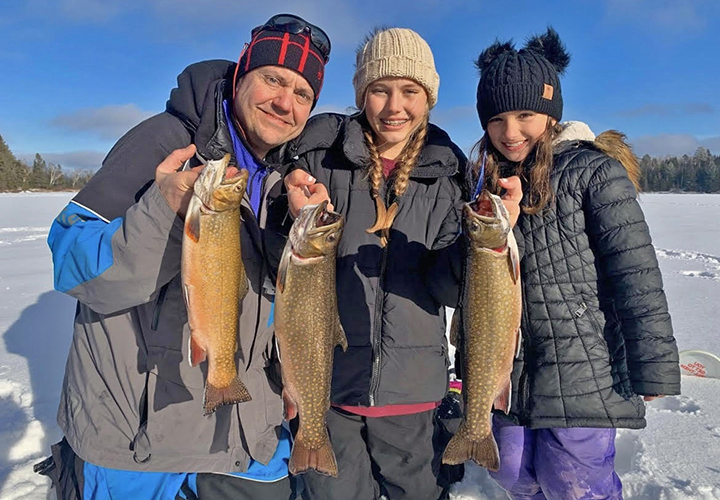 "Ice Report • With cold weather and some serious cold temperatures are forecasted for early next week, ice conditions continue to improve everywhere in the Ely area. As much as 20+ inches of ice is now being reported and ice roads have popped up. As much a 4 inches of new snow now covers area lakes, so now snowmobiles are a common sight on area lakes.
"Ice Report • With cold weather and some serious cold temperatures are forecasted for early next week, ice conditions continue to improve everywhere in the Ely area. As much as 20+ inches of ice is now being reported and ice roads have popped up. As much a 4 inches of new snow now covers area lakes, so now snowmobiles are a common sight on area lakes.
Fishing Report • Walleye fishing continues to be on the slow side but a handful of good bites were reported this last week. These good bites happened in 26 to 30 feet of water. Deadsticking a minnow, during the morning and evening hours has been the bite window. If deep is not happening for you 12 feet of water continues to be another good depth to catch walleyes during the bite windows.
Lake Trout • Lake trout fishing in the BWCA continues to be good to excellent for many anglers willing to walk in. Key depths continue to be that 30 to 50 foot range, close to deep water. Tubes, bucktails, tipped with a sucker, have been an excellent choice. Red, blue and chartreuse colored tubes have been hot.
Stream Trout • Brook trout fishing has been good for many anglers fishing in the BWCA. Anglers have been focusing on downed timber, weeds and beaver houses for brookies. Small jigging spoons, tungsten jigs, tipped with a wax worm or dead minnow have been very effective.
Northern Pike • Pike have slowed up, but more likely because of the cold temps make it challenging to keep a hole open. Anglers fishing from heated houses reported catching a handful of pike but the average size was on the small side. With a short warmup forecasted anglers should focus on river mouths and weedbeds in 5 to 12 feet of water. Medium to large suckers are always a good choice for tip ups.
Panfish • With the drop in temps last week the panfish bite also dropped. Anglers reported that they could find crappies and sunfish in 25 to 30 feet of water, but they often struggled to get them to bite. Downsizing to 1/32 ounce jigs and tipped them with a wax worm or two, accounted for the majority of fish caught." — Arrowhead Outdoors, 218-365-5358
 Lake of the Woods, LOW Tourism January 14, 2025
Lake of the Woods, LOW Tourism January 14, 2025
 "Ice fishing is going great on the south shore of Lake of the Woods. Traffic is heavy, with resorts and outfitters reporting upwards of two feet of ice in some areas. Every ice road has different weight limits, so check with each resort for details before traveling up. As of now, operators are allowing up to 1 ton vehicles pulling a wheelhouses on many ice roads.
"Ice fishing is going great on the south shore of Lake of the Woods. Traffic is heavy, with resorts and outfitters reporting upwards of two feet of ice in some areas. Every ice road has different weight limits, so check with each resort for details before traveling up. As of now, operators are allowing up to 1 ton vehicles pulling a wheelhouses on many ice roads.
Some good fishing this past week. As a rule, fishing activity is happening in 28 to 32 feet of water. Resorts do just about everything they can to get customers on fish and this past week, some resorts made some long runs, resetting fish houses in new areas miles off shore. Most are reporting good fishing as a rule.
It is common to sort through some small walleyes and saugers to get your keepers on LOW. Naturally, some big fish are showing up, especially in deeper water. In addition, this has been a very good year for jumbo perch with good numbers being caught. Other fish in the mix are eelpout (burbot), pike, tullibees and an occasional sturgeon.
Anglers are using the one-two punch of jigging in one hole and deadsticking the second hole. In the jigging hole, a jigging spoon tipped with a minnow head. Effective color combinations include gold and pink, gold and glow red, glow white and pink, and the "Wonder Bread" color pattern. Some anglers are also finding success on rippin' raps or using jigging spoons with a rattles, especially in the deeper water,
 On the deadstick, a small jig with a live minnow hooked behind the dorsal fin set 6 inches to one foot off of the bottom is working well. One day the jigging line catches most of the fish, the other day a deadstick is hot.
On the deadstick, a small jig with a live minnow hooked behind the dorsal fin set 6 inches to one foot off of the bottom is working well. One day the jigging line catches most of the fish, the other day a deadstick is hot.
Electronics are very helpful to see suspended fish, know when fish are coming through and adjust your presentation to the mood of each fish. Most resorts, outfitters and bait shops in the area rent electronics by the day.
The Rainy River is still producing some nice walleyes and saugers, primarily in the mornings and evenings. A jig and minnow working well. Catch-and-release sturgeon fishing continues to be good for those targeting them. An oversized hole, or three holes drilled together, with nightcrawlers or frozen emerald shiners on a sturgeon rig fished on the bottom are what anglers are using.
Ice conditions on the river can vary significantly due to the current. To stay safe and maximize success, always work with a local resort or outfitter familiar with river conditions.
Up at the Northwest Angle, the ice road from Jerry's on the mainland (Angle Inlet, MN) to island resorts (as of this past week) was open to 1 ton vehicles. Guests drive right to their island resort after picking up a road pass at Jerry's or Point North Services. Venmo is also available at all resorts. Work through your resort for specifics.
ice fishing at the Northwest Angle continues to be very good too. Resorts have fish houses set up on various pieces of structure as well as adjacent to structure in deep mud. A consistent mix of walleyes, saugers, jumbo perch, pike and tullibees in the mix. Shallow structure is best right away in the morning and as the sun starts going down in the late afternoon. Mud is more of a slower bite but all day." — Lake of the Woods Tourism, (800) 382-FISH
 News Release January 14, 2025 "Minnesota DNR seeks public input on updates to Lake of the Woods Fisheries Management Plan"
News Release January 14, 2025 "Minnesota DNR seeks public input on updates to Lake of the Woods Fisheries Management Plan"
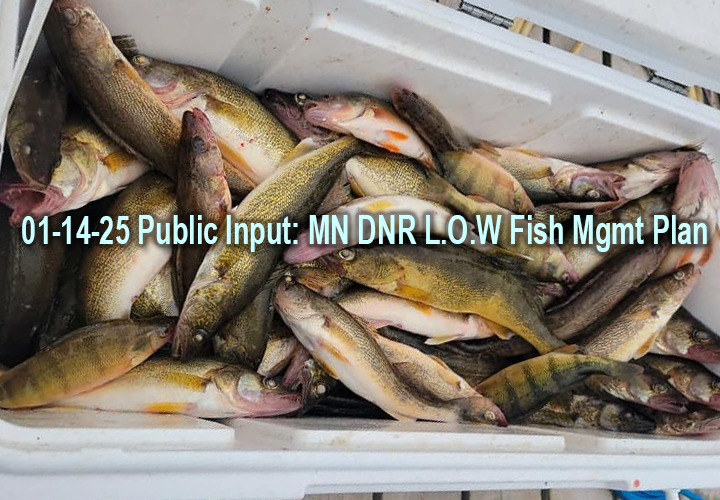 The Minnesota Department of Natural Resources invites people interested in Lake of the Woods fisheries to share their thoughts on a draft update of the fisheries management plan for the lake. This opportunity differs from the scoping survey released in February 2024. The scoping survey guided the management planning process, while this is an opportunity to comment on the draft plan.
The Minnesota Department of Natural Resources invites people interested in Lake of the Woods fisheries to share their thoughts on a draft update of the fisheries management plan for the lake. This opportunity differs from the scoping survey released in February 2024. The scoping survey guided the management planning process, while this is an opportunity to comment on the draft plan.
The Lake of the Woods Fisheries Management Plan was last updated in 2018. It is important for this update to reflect current public values and attitudes about how the lake should be managed. The updated master plan will be used to guide management of Lake of the Woods fish populations. It will include management goals, objectives and strategies for the lake for the next 10 years.
Public input opportunities: Minnesota DNR staff will host a joint in-person and virtual public meeting to provide an overview of the plan and its purpose, answer questions, and collect public input. Registration is not required.
The meeting will be held 6:30 to 8:30 p.m. Wednesday, February 5, 2025 at the Baudette Ambulance Garage Conference Room, 113 1st Ave. SW, Baudette, MN 56623. For people who would like to join virtually, a link to join the webinar is available on the Lake of the Woods page (mndnr.gov/lakeofthewoods) of the Minnesota DNR website.
Review and comment on the plan: The public can obtain a digital copy of the draft update on the Lake of the Woods page (mndnr.gov/lakeofthewoods). Comments may be submitted by:
- Using the online form available at the Lake of the Woods webpage (mndnr.gov/lakeofthewoods).
- Emailing baudette.fisheries@state.mn.us.
- Calling Baudette area fisheries staff at 218-395-6040.
- Mailing comments to 204 Main St. E, Baudette, MN 56623.
- Providing verbal and written comments at the Feb. 5 joint in-person and virtual meeting.
The Minnesota DNR is accepting comments on the draft master plan through Sunday, February 16, 2025
About the lake: Lake of the Woods is a large lake that is located on the United States-Canada border. Approximately 300,000 acres of Lake of the Woods are located within the U.S. The Minnesota portion of Lake of the Woods includes several distinct basins, including Muskeg Bay, Big Traverse Bay and Little Traverse Bay. Lake of the Woods is a popular recreational fishing destination for both summer and winter anglers. Some of the more popular species anglers target when visiting the lake include walleye, sauger, yellow perch, lake sturgeon and northern pike. Intensive monitoring of the fish populations occurs on an annual basis due to the popularity of this resource.
More information about Lake of the Woods is available on the Minnesota DNR website (mndnr.gov/lakeofthewoods)."
 Ely Area, Arrowhead Outdoors Fishing Report January 9, 2025
Ely Area, Arrowhead Outdoors Fishing Report January 9, 2025
 Ice Report - Much needed cold snap continues to make quality ice on Ely area lakes. 12 to 20 inches of ice is now being reported on Ely area lakes. 4 wheelers, side by sides, cars and trucks are now driving around on many of the lakes.
Ice Report - Much needed cold snap continues to make quality ice on Ely area lakes. 12 to 20 inches of ice is now being reported on Ely area lakes. 4 wheelers, side by sides, cars and trucks are now driving around on many of the lakes.
Anglers planning on coming up for the 2025 winter trout opener on January 18, 2025, should know that stream trout and lake trout lake ice is now being reported to be between 12 to 18 inches of ice. Unless we get a dumping of snow, which is not forecasted, 4 wheelers and side by sides are going to be the best ways to travel on all lakes, opening weekend.
Fishing Report - Walleye fishing continues to be typical January walleye fishing. Slow. Best time continues to be during the evening hours with a lively minnow deadsticked. Anglers have also reported catching a few walleyes overnight on rattle reels. Best depth continues to be in that 12 to 20 feet of water. Large mud flats in these depths continue to be the best producers.
Lake trout fishing in the BWCA (outside the BWCA opens January 18, 2025) started out with a bang and has remained excellent for many who have made the trek into the BWCA. Best fishing was in 40 to 60 feet of water, near flats, humps and points. Tubes and flukes, fished 20 to 40 feet down were very effective for lakers.
Stream Trout - Brook Trout fishing in the BWCA (outside the BWCA opens January 18, 2025) also was excellent for many anglers. Brook Trout angler's focused on shallow shorelines In 10 feet of water and shallower for brookies. Downed trees and weeds had the best fishing. Small jigging spoons and tungsten jigs tipped with wax worms produced good numbers of trout.
Northern Pike anglers continue to target big pike with tip ups on many Ely area lakes. Medium to large suckers, fished in weedbeds in 5 to 12 feet of water have been producing good numbers and size pike.
Panfish - Both crappies and sunfish have cooled off as air temperatures have dropped. Crappies and sunnies are being found in 20 to 25 feet of water and tight to the bottom. Small tungsten jigs tipped with wax worms or crappie minnows have been the best way to approach these negative fish." — Arrowhead Outdoors, 218-365-5358
 Wired2Fish January 9, 2025 "Top 4 Baits for Forward-Facing Sonar Success | Mark Daniels Jr."
Wired2Fish January 9, 2025 "Top 4 Baits for Forward-Facing Sonar Success | Mark Daniels Jr."
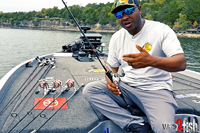 "Join professional angler Mark Daniels Jr. as he shares his go-to baits and proven techniques for making the most of forward-facing sonar. Daniels demonstrates how these tools can help you target fish with precision whether you’re fishing offshore or near cover, and land more bites.
"Join professional angler Mark Daniels Jr. as he shares his go-to baits and proven techniques for making the most of forward-facing sonar. Daniels demonstrates how these tools can help you target fish with precision whether you’re fishing offshore or near cover, and land more bites.
JERKBAIT: The jerkbait tops Daniels’ list for forward-facing sonar applications. Its versatility lies in how you can impart custom bait action to the mood of the fish—just figure out what makes ’em tick and voilà, you trigger a bite! Using Garmin LiveScope, Daniels watches fish react to his bait and adjusts his jerk cadence and retrieve speed accordingly. This approach transforms fishing into an engaging game of cat and mouse.
DROP SHOT RIG: Daniels reaches for the drop shot rig when bass ..." View Video and Learn More >> Top 4 Baits for Forward-Facing Sonar Success | Mark Daniels Jr.
 News Release January 2025 "Minnesota DNR looking to fill 200 paid summer internships"
News Release January 2025 "Minnesota DNR looking to fill 200 paid summer internships"
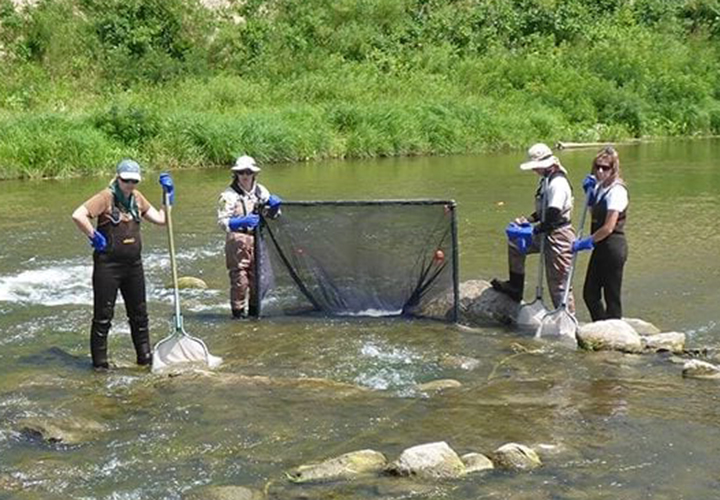 "The Minnesota Department of Natural Resources is looking for passionate and dedicated students interested in learning more about natural resource careers through paid summer internships.
"The Minnesota Department of Natural Resources is looking for passionate and dedicated students interested in learning more about natural resource careers through paid summer internships.
DNR summer interns receive valuable training, develop key skills and contribute in important ways to the department’s mission of working with Minnesotans to conserve and manage natural resources, provide outdoor recreational opportunities, and provide for commercial uses of natural resources in a way that creates a sustainable quality of life.
The DNR has a wide variety of internship opportunities throughout the state, including in fisheries, forestry, park operations, watercraft inspections, communications and more. Interns work 20 to 40 hours per week and receive a competitive wage of $19 per hour. To be considered for an internship, fulfilling an academic requirement or receiving academic credit is required.
To review the internship opportunities and apply for those of interest, click here to visit >> State of Minnesota Careers Website. opens in a new browser ta Select “Search for jobs” from the toolbar. In the External Applicants box, select “Search for jobs now” and select “View all jobs.” Filter by “Natural Resources Dept” in the Agency category and “Student Worker and Internships” in the Job Family category.
Internship applications will be accepted through January 31, 2025. Positions will start in May and June, 2025. Applicants seeking employment with the DNR who are not eligible for an internship should regularly check the website for seasonal and year-round opportunities."
 Lake of the Woods, LOW Tourism January 7, 2025
Lake of the Woods, LOW Tourism January 7, 2025
lake_of_the_woods_ice_fishing_report_clear.png) "On the South Shore of Lake of the Woods, anglers will find that ice fishing is in full swing. Access increases daily as resorts and outfitters continuing to report solid ice conditions and some good fishing. Many ice roads are now open to 1 ton vehicles pulling a wheelhouse. Every road has different weight limits, check with each resort for details before traveling up and out on the ice.
"On the South Shore of Lake of the Woods, anglers will find that ice fishing is in full swing. Access increases daily as resorts and outfitters continuing to report solid ice conditions and some good fishing. Many ice roads are now open to 1 ton vehicles pulling a wheelhouse. Every road has different weight limits, check with each resort for details before traveling up and out on the ice.
Most fishing activity is happening in 26 to 32 feet of water. Most anglers are sorting through some small fish to catch their keepers with an occasional slot or trophy walleye. Most buckets have some good quality walleyes and saugers. Jumbo perch, northern pike, and large eelpout are also adding excitement to the mix, with a few sturgeon showing up as well.
Anglers are using the one-two punch of jigging in one hole and deadsticking the second hole. In the jigging hole, your favorite small to mid sized jigging spoon in gold, glow red, glow white, pink, chartreuse or a combo of these colors tipped with a minnow head. Rattles can help as well in the stained water. Some anglers are finding success on jigging raps and rippin raps as well. More aggressive techniques at times are really getting it done. On the deadstick, a small jig with a live minnow hooked behind the dorsal fin set 6 inches to one foot off of the bottom is working well.
 Using electronics is very helpful to see suspended fish, know when fish are coming through and adjust your presentation to the mood of each fish.
Using electronics is very helpful to see suspended fish, know when fish are coming through and adjust your presentation to the mood of each fish.
The Rainy River is still producing some nice fish but the good early ice walleye bite has slowed somewhat. Anglers are catching some decent numbers of walleyes and saugers, with several nice-sized sturgeon showing up nicely for those angling for them. However, caution remains crucial on the river, as ice conditions can vary significantly due to the current. Catch-and-release sturgeon fishing continues to be good. To stay safe and maximize success, always work with a local resort or outfitter familiar with river conditions.
Up at the Northwest Angle, ice fishing is going very well. Resorts have fish houses out with anglers already enjoying excellent success. "The Angle" is delivering its usual consistent fishing, with a nice mix of walleyes, saugers, jumbo perch, and pike being caught. Resorts and outfitters in the area are working hard to place fish houses on points, reefs and over deep mud.
Ice fishing is in full swing and there are openings for lodging and fish house rentals on both ends of the lake." — Lake of the Woods Tourism, (800) 382-FISH
 Ely Area, Arrowhead Outdoors Ice Fishing Report January 2, 2025
Ely Area, Arrowhead Outdoors Ice Fishing Report January 2, 2025
 Ice Report: After a few days of rain, Ely area lakes have lost all the snow on top, but not very much ice. With a good cold snap forecasted for the next week and beyond, ice conditions have steadily improving on area lakes. Anglers have been reporting 8 to 13 inches of good ice. ATVs, 4 wheelers and side by sides have become common forms of travel on area lakes with a few lakes trucks are starting to showing up out on the ice. Permanent houses are now a common sight on Ely area lakes.
Ice Report: After a few days of rain, Ely area lakes have lost all the snow on top, but not very much ice. With a good cold snap forecasted for the next week and beyond, ice conditions have steadily improving on area lakes. Anglers have been reporting 8 to 13 inches of good ice. ATVs, 4 wheelers and side by sides have become common forms of travel on area lakes with a few lakes trucks are starting to showing up out on the ice. Permanent houses are now a common sight on Ely area lakes.
Ice Fishing Report: Walleye fishing continues to be slow for anglers. The few decent reports have been coming in 10 to 15 feet of water during the morning and evening hours. Small minnows, on a small jig and deadsticked, has been the most productive technique this last week. Look to rocky bottoms and river mouths
Northern Pike fishing continues to be good and consistent for many anglers targeting them. Some large pike have been coming on tip ups, tipped with a medium to large sucker. Shallow weedbeds in 5 to 12 feet of water continue to be the best areas to target.
Panfish, crappies and bluegills continue to be slow but steady for many anglers. Anglers have been catching both in deeper holes around 18 to 25 feet of water. Small jigs tipped with wax worm have been best for gill while a small jig tipped with either soft plastics or crappie minnow has been best for the crappies. White, pink and purple have been the best colors for panfish." — Arrowhead Outdoors, 218-365-5358
 Wired2Fish January 2, 2025 "Gear Test: Gill Meridian-X Waterproof Jacket and Bibs"
Wired2Fish January 2, 2025 "Gear Test: Gill Meridian-X Waterproof Jacket and Bibs"
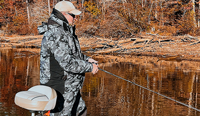 "When the mercury plummets, you better be wearing the right cold weather gear. As far as first-world problems go, there’s nothing more miserable than getting cold in the morning of a long winter day on the water and never being able to warm back up. I was at risk of doing just that last Saturday while fishing a local pot tournament on Lake Martin here in central Alabama. It’s a good thing I happened to be testing out the Gill Meridian-X Waterproof Bib and Jacket.
"When the mercury plummets, you better be wearing the right cold weather gear. As far as first-world problems go, there’s nothing more miserable than getting cold in the morning of a long winter day on the water and never being able to warm back up. I was at risk of doing just that last Saturday while fishing a local pot tournament on Lake Martin here in central Alabama. It’s a good thing I happened to be testing out the Gill Meridian-X Waterproof Bib and Jacket.
The air temp was hovering around 30 degrees when we took off and the water temps were in the mid 40s when we dropped the trolling motor in the water. Our rod guides clogged up with ice every 10 casts for about the first hour, and there was ice on the water’s surface in the ..." Read Article and Learn More >> Gear Test: Gill Meridian-X Waterproof Jacket and Bibs
 Lake of the Woods, LOW Tourism January 1, 2025
Lake of the Woods, LOW Tourism January 1, 2025
 "Ice fishing is in full swing along the south shore of Lake of the Woods. Resorts and outfitters are continuing to report solid ice conditions. A colder weather pattern is expected over the next couple of weeks, which will further strengthen ice and ensure safe and productive fishing. Many resorts have sleeper fish houses on the ice, offering anglers the chance to spend extended time fishing in comfort.
"Ice fishing is in full swing along the south shore of Lake of the Woods. Resorts and outfitters are continuing to report solid ice conditions. A colder weather pattern is expected over the next couple of weeks, which will further strengthen ice and ensure safe and productive fishing. Many resorts have sleeper fish houses on the ice, offering anglers the chance to spend extended time fishing in comfort.
Although every ice road is different, many are now allowing mid-sized vehicles as ice thickness improves. Be sure to check with your ice road operator for specific conditions and weight limits to ensure a safe outing.
Most fishing activity is happening in 24 to 30 feet of water, where anglers are reporting steady action. While some sorting is required to find keeper-sized fish, buckets are being filled with quality walleyes and saugers. Jumbo perch, northern pike, and large eelpout are also adding excitement to the mix, with a few sturgeon showing up to surprise anglers as well.
 Anglers are using the one-two punch of jigging in one hole and deadsticking the second hole. In the jigging hole, your favorite jigging spoon in gold, glow red, glow white, pink, chartreuse or a combo of these colors. Rattles can help as well in the stained water. On the deadstick, a small jig with a live minnow hooked behind the dorsal fin set 6 inches - a foot off of the bottom is working well.
Anglers are using the one-two punch of jigging in one hole and deadsticking the second hole. In the jigging hole, your favorite jigging spoon in gold, glow red, glow white, pink, chartreuse or a combo of these colors. Rattles can help as well in the stained water. On the deadstick, a small jig with a live minnow hooked behind the dorsal fin set 6 inches - a foot off of the bottom is working well.
The Rainy River continues to produce great results for those heading out. Anglers are catching good numbers of walleyes and saugers, with several nice-sized sturgeon showing up nicely for those angling for them. However, caution remains crucial on the river, as ice conditions can vary significantly due to the current. Catch-and-release sturgeon fishing has been excellent, offering a thrilling battle for anglers seeking a unique challenge. To stay safe and maximize success, always work with a local resort or outfitter familiar with river conditions.
Ice fishing is going strong up at the Northwest Angle too. Resorts have fish houses out with anglers already enjoying excellent success.The NW Angle is delivering its usual consistent fishing, with a nice mix of walleyes, saugers, jumbo perch, and pike being caught. Resorts and outfitters in the area are working hard to ensure safe ice conditions, with marked trails and ready-to-fish houses set up for a seamless experience. Check with your favorite NW Angle resort for details.
Good news for snowmobilers: the snowmobile trail from the south end of the lake across the ice to the Northwest Angle is staked and open! Scratchers are recommended with some melting snow last week.
Happy Holidays from Lake of the Woods Tourism! Tight lines and safe fishing!" — Lake of the Woods Tourism, (800) 382-FISH
You Are Invited To Become A Duly Deputized Fishrapper Cub Reporter Too!
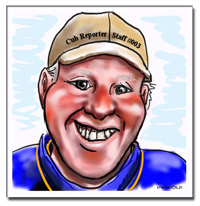 If you've been waiting for a gold engraved invitation to participate in the daily reports, then stop waiting and consider this your own personal invitation.
If you've been waiting for a gold engraved invitation to participate in the daily reports, then stop waiting and consider this your own personal invitation.
Helping your fellow fishermen and women stay abreast of fishing conditions in your area is good for everybody and it's easier than you think! You don't have to write a book, you don't have to share your secret fishing spots and you don't even have to mention your lake. But even a few words about general trends, seasonal patterns and local weather conditions can really help.
Be like me, become a duly deputized "Cub Reporter", it's good for fishing! Contact Us or if you prefer to be "social", Fishing Reports Minnesota, the Facebook counterpart to this page is open to the public, so you can post your own fishing update or just share a photo of a nice catch.